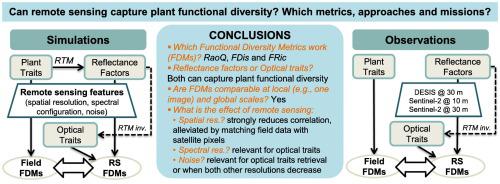Remote Sensing of Environment ( IF 11.1 ) Pub Date : 2022-07-18 , DOI: 10.1016/j.rse.2022.113170 Javier Pacheco-Labrador , Mirco Migliavacca , Xuanlong Ma , Miguel D. Mahecha , Nuno Carvalhais , Ulrich Weber , Raquel Benavides , Olivier Bouriaud , Ionut Barnoaiea , David A. Coomes , Friedrich J. Bohn , Guido Kraemer , Uta Heiden , Andreas Huth , Christian Wirth

|
In a context of accelerated human-induced biodiversity loss, remote sensing (RS) is emerging as a promising tool to map plant biodiversity from space. Proposed approaches often rely on the Spectral Variation Hypothesis (SVH), linking the heterogeneity of terrestrial vegetation to the variability of the spectroradiometric signals. Yet, due to observational limitations, the SVH has been insufficiently tested, remaining unclear which metrics, methods, and sensors could provide the most reliable estimates of plant biodiversity. Here we assessed the potential of RS to infer plant biodiversity using radiative transfer simulations and inversion. We focused specifically on “functional diversity,” which represents the spatial variability in plant functional traits. First, we simulated vegetation communities and evaluated the information content of different functional diversity metrics (FDMs) derived from their optical reflectance factors (R) or the corresponding vegetation “optical traits,” estimated via radiative transfer model inversion. Second, we assessed the effect of the spatial resolution, the spectral characteristics of the sensor, and signal noise on the relationships between FDMs derived from field and remote sensing datasets. Finally, we evaluated the plausibility of the simulations using Sentinel-2 (multispectral, 10 m pixel) and DESIS (hyperspectral, 30 m pixel) imagery acquired over sites of the Functional Significance of Forest Biodiversity in Europe (FunDivEUROPE) network. We demonstrate that functional diversity can be inferred both by reflectance and optical traits. However, not all the FDMs tested were suited for assessing plant functional diversity from RS. Rao's Q index, functional dispersion, and functional richness were the best-performing metrics. Furthermore, we demonstrated that spatial resolution is the most limiting RS feature. In agreement with simulations, Sentinel-2 imagery provided better estimates of plant diversity than DESIS, despite the coarser spectral resolution. However, Sentinel-2 offered inaccurate results at DESIS spatial resolution. Overall, our results identify the strengths and weaknesses of optical RS to monitor plant functional diversity. Future missions and biodiversity products should consider and benefit from the identified potentials and limitations of the SVH.
中文翻译:

通过辐射传输建模和数据挑战功能多样性和光谱多样性之间的联系
在人类引起的生物多样性加速丧失的背景下,遥感 (RS) 正在成为一种很有前途的工具,可以从太空绘制植物生物多样性图。提出的方法通常依赖于光谱变化假设 (SVH),将陆地植被的异质性与光谱辐射信号的可变性联系起来。然而,由于观测限制,SVH 尚未得到充分测试,尚不清楚哪些指标、方法和传感器可以提供最可靠的植物生物多样性估计。在这里,我们评估了 RS 使用辐射传输模拟和反演来推断植物生物多样性的潜力。我们特别关注“功能多样性”,它代表了植物功能性状的空间变异性。第一的,R ) 或相应的植被“光学特征”,通过辐射传输模型反演估计。其次,我们评估了空间分辨率、传感器的光谱特性和信号噪声对来自现场和遥感数据集的 FDM 之间关系的影响。最后,我们使用在欧洲森林生物多样性的功能意义 (FunDivEUROPE) 网络上获取的 Sentinel-2(多光谱,10 m 像素)和 DESIS(高光谱,30 m 像素)图像评估了模拟的合理性。我们证明了功能多样性可以通过反射率和光学特性来推断。然而,并非所有测试的 FDM 都适合从 RS 评估植物功能多样性。饶的Q指数、功能分散性和功能丰富度是表现最好的指标。此外,我们证明了空间分辨率是最具限制性的 RS 特征。与模拟一致,Sentinel-2 图像提供了比 DESIS 更好的植物多样性估计,尽管光谱分辨率较粗。然而,Sentinel-2 在 DESIS 空间分辨率下提供的结果不准确。总体而言,我们的结果确定了光学 RS 在监测植物功能多样性方面的优势和劣势。未来的任务和生物多样性产品应考虑并受益于已确定的 SVH 潜力和局限性。











































 京公网安备 11010802027423号
京公网安备 11010802027423号